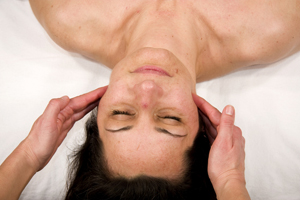arm & shoulder
 Shoulder PainStrong and flexible arms and shoulders not only help us in our work environment, with lifting and reaching for objects, they are also essential to most athletic endeavours, from perfecting that golf or tennis swing to throwing a football or hitting a baseball with precision. Joints and muscles in these parts of the body allow for a tremendous range of motion, but it can be restricted when suffering from injury or other sources of pain.
Shoulder PainStrong and flexible arms and shoulders not only help us in our work environment, with lifting and reaching for objects, they are also essential to most athletic endeavours, from perfecting that golf or tennis swing to throwing a football or hitting a baseball with precision. Joints and muscles in these parts of the body allow for a tremendous range of motion, but it can be restricted when suffering from injury or other sources of pain.Shoulder and arm pain can come from several different sources. Injury in the neck or upper body can cause pain referral into the shoulder and arm, or injuries of the muscles, nerves, joints and ligaments of the arm and shoulder can be injured directly.
Nerve “pinch”
Often pain referring down the arm is blamed on a “pinched nerve”. Nerves can be “pinched” in the neck/upper back from a disc injury, with osteoarthritis and degenerative changes or from an injury.
- typical nerve pain is severe and sharp/stabbing
- can cause numbness, total loss of feeling or weaknesses
- true nerve compression is not very common. More often pain referral stems from muscle, joint and disc problems
- even if the nerve is not being directly compressed the pain can still be severe
The arm, shoulder and hand contain over 40 different muscles. Muscle strains are very common, especially following physical activity.
- pain can range from minor stiffness to severe pain
- pain often triggered with stretching or resisted activity
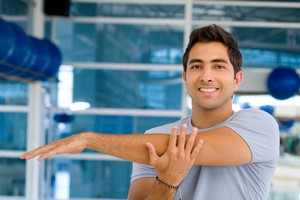 Upper Arm PainShoulder joint
Upper Arm PainShoulder jointThe shoulder is a highly mobile joint -- and therefore has a high risk of injury.
Shoulder dislocation or instability
- typically results from a fall or trauma
- may feel shoulder "going out of joint" with certain movements
- adhesive capsulitis
- progressive loss of shoulder mobility in almost all directions typically following an injury
- untreated may take 4 years to improve (and still not fully recover)
- often attempt treatment with cortisone injections or medications -- but this only obscures symptoms for a short period.
 Lower Arm PainRotator Cuff
Lower Arm PainRotator Cuff- muscles stabilizing and supporting the shoulder joint are at high risk of injury -- acute injury or repetitive strain can lead to "tendinopathy"
- important to properly retrain the muscles to avoid re-injury
- can also include bursitis (irritation of the lubricant fluid sac)
The ac joint is an attachment between the collarbone and shoulder blade
- typically traumatic onset
- injury can damage stabilizing ligament
 Elbow PainThe most common injury around the elbow is referred to as "tennis elbow" with pain on the outside of the elbow (a similar problem "golfers elbow" is on the inside")
Elbow PainThe most common injury around the elbow is referred to as "tennis elbow" with pain on the outside of the elbow (a similar problem "golfers elbow" is on the inside")- technically a tendinopathy (chronically irritated tendon tissue)
- repetitive strain injury
- pain with resisted movements and even light activities
- often becomes very chronic -- but can resolved with conservative treatment rather than injections that just mask the pain
Wrist and hand pain
Carpal tunnel syndrome is a common cause of wrist and hand pain.
- weakness in the hand and numbness in the 1-4th digits
- typically triggered from repetitive strain and irritation in the tendon of the wrist
- often recovers with conservative treatment rather than surgery
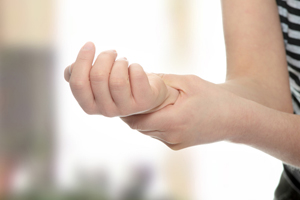 Wrist PainTreatment
Wrist PainTreatmentTreatment must always start with an appropriate diagnosis.
Treatments should focus on the underlying cause of the pain - both the tissue causing the pain as well as the factors triggering the problem. A combination of treatments, such as, massage, soft tissue treatments (Graston), manipulation/mobilization and/or home stretching exercises can be effective ways to reduce the tissue irritation.
We identify any aggravating factors and help you manage any issues through a program of self-care and prevention.
For a clinical assessment of your arm and shoulder pain, the triggers and best treatment options, please contact Bedford Chiropractic for an appointment.
headaches & neck pain
 HeadachesHeadaches
HeadachesHeadachesHeadaches are quite common, especially in women. Current estimates suggest that 27% of women and 14% of men suffer from severe headaches. 90% of headaches pose no imminent danger, other than ongoing pain and disability for the headache sufferer, but a small percentage of headaches are of a more sinister nature with an underlying disease or illness. Severe or chronic headaches rob your enjoyment of life and can be dihibilatating, affecting your efforts to concentrate, calculate and think clearly.
Common headaches can be groups into these categories, with associated symptoms:
Migraine headaches
- typically throbbing pain in one or both eyes
- pain level can be extreme
- may also include some visual disturbance (blurring, tunnel vision, sparkles)
 Neck PainTension headaches
Neck PainTension headaches- dull pain or pressure typically across the forehead and temples
- defined as headache pain that originates from the neck
- can develop from muscle, joint or nerve irritation
- often dull aching pain in the back of the skull, forehead and/or temples, but can be sharp pain as well
Treatment must always start with an appropriate diagnosis.
 WhiplashTreatments should focus on the underlying cause of the pain - both the tissue causing the pain as well as the factors triggering the problem. A combination of treatments, such as, massage, soft tissue treatments (Graston), manipulation/mobilization and/or home stretching exercises can be effective ways to reduce the tissue irritation.
WhiplashTreatments should focus on the underlying cause of the pain - both the tissue causing the pain as well as the factors triggering the problem. A combination of treatments, such as, massage, soft tissue treatments (Graston), manipulation/mobilization and/or home stretching exercises can be effective ways to reduce the tissue irritation.We identify any aggravating factors and help you manage any issues through a program of self-care and prevention.
For a clinical assessment of your headache pain, the triggers and best treatment options, please contact Bedford Chiropractic for an appointment.
hip & leg
 Hip PainHip and leg pain can come from several different sources. Injury in the lower back can cause pain referral into the hip and leg, or the pain may be the direct result of injury to the muscles, nerves, joints and/or ligaments of the leg and hip.
Hip PainHip and leg pain can come from several different sources. Injury in the lower back can cause pain referral into the hip and leg, or the pain may be the direct result of injury to the muscles, nerves, joints and/or ligaments of the leg and hip.Nerve “pinch”
Often pain referring down the leg is blamed on “sciatica" or a "pinched nerve". Nerves can be “pinched” in the lower back from a disc injury, with osteoarthritis and degenerative changes or from an injury.
- typical nerve pain is severe and sharp/stabbing
- can cause numbness, total loss of feeling or weaknesses
- true nerve compression is not very common. More often pain referral stems from muscle, joint and disc problems – even if the nerve is not being directly compressed the pain can still be severe
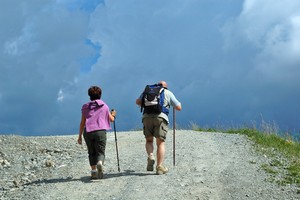 Strained MusclesMuscle strain and myofascial pain
Strained MusclesMuscle strain and myofascial painThe leg, hip and foot contain dozens of different muscles. Muscle strains are very common, especially following physical activity.
- Pain can range from minor stiffness to severe pain and can refer pain throughout the leg and hip
- Pain is often triggered with stretching or resisted activity
The hip joint supports the entire body and has significant mobility. Because the joint itself is fairly stable, injuries are not as common as in other joints. Repetitive injuries can degrade the cartilage, leading to osteoarthritis.
Often "hip" pain is actually a muscle problem or tendon irritation from repetitive strains (tendinopathy).
 Knee PainKnee pain
Knee PainKnee painKnee pain is very common - often as a result of problems in other areas. Abnormal motion in the hip or foot/ankle can put excess strain on the knee and cause pain. The knee cap or patella is a common location of pain, either due to chronic strain (tendinopathy) or abnormal motion (patello-femoral syndrome).
- painful going up and down stairs
- often sore after activity
- usually can be resolved by treatment and exercises
- injured with twisting and compression, the meniscus can tear
- often feels like a catching or locking
- can be very painful
- may require surgery, but can often be managed with treatment and exercises
Hip and Knee pain can also be a result of bursitis, irritation of the lubricant fluid sac.
- can develop into a very swollen mass
- very sensitive
Sprains and strains are common in the foot/ankle joints and muscles. They often respond well to conservative treatments.
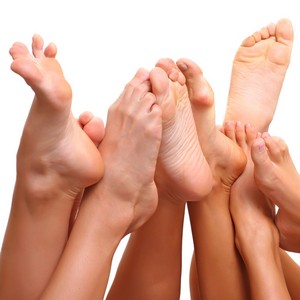 Foot and Ankle PainWe also see a lot of problems related to poor biomechanics in the feet. Wearing proper shoes with good support is a start, but some people need orthotics to help correct the problem.
Foot and Ankle PainWe also see a lot of problems related to poor biomechanics in the feet. Wearing proper shoes with good support is a start, but some people need orthotics to help correct the problem.The Achilles tendon is also at risk of injury, either from repetitive strain or acute injury. Severe tears may require surgery but most problems can be managed with treatment and exercises.
Often pain is blamed on osteoarthritis. Degenerative damage like osteoarthritis can trigger pain episodes, but that pain often persists for other reasons. The goal of treatment is to identify the underlying factors for the reoccuring pain, and to bring those issues under control with a combination of treatment, home exercises and ergonomic changes.
Treatment
Treatment must always start with an appropriate diagnosis.
 TreatmentTreatments should focus on the underlying cause of the pain - both the tissue causing the pain as well as the factors triggering the problem. A combination of treatments, such as, massage, soft tissue treatments (Graston), manipulation/mobilization and/or home stretching exercises can be effective ways to reduce the tissue irritation.
TreatmentTreatments should focus on the underlying cause of the pain - both the tissue causing the pain as well as the factors triggering the problem. A combination of treatments, such as, massage, soft tissue treatments (Graston), manipulation/mobilization and/or home stretching exercises can be effective ways to reduce the tissue irritation.We identify aggravating factors and help you manage any issues through a program of self-care and prevention.
For a clinical assessment of your hip and leg pain, the triggers and best treatment options, please contact Bedford Chiropractic for an appointment.
lower back pain
 Lower Back PainLower back injuries are very common. Research tells us that 80% of people suffer from back pain at some time or another. Back pain is one of the leading causes of disability with significant health care costs in addition to lost productivity and suffering.
Lower Back PainLower back injuries are very common. Research tells us that 80% of people suffer from back pain at some time or another. Back pain is one of the leading causes of disability with significant health care costs in addition to lost productivity and suffering.Problems or injuries to the muscles, nerves, joints and discs are the most common causes of low back pain. With overlapping injuries and possibly more than one area or tissue injured, differentiating the specific injury can be difficult. This is a brief list of the different problems and typical associated symptoms that we commonly see. This general information is offered to help you better understand the possible problems. For more specific information please schedule a consultation.
Disc injury
The flexible discs between vertabrea allow for movement, but are a frequent source of pain in the lower back. With damage ranging from a minor sprain (internal disruption) to a severe herniation, the pain level can also vary from minor to severe.
- Pain referral or radiation is common – with symptoms including numbness, pain or weaknesses into the hip or leg
- Will often restrict mobility
- Typical pattern includes early morning pain, pain with sitting, relief with standing/walking
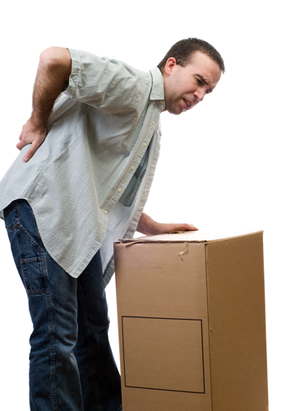 Lifting Injury
Lifting InjuryJoint “sprain”
Between each vertebrae there are small joints (facet joints) that help guide motion – excess stress/strain on these small joints can result in a joint “sprain” or irritation.
- Pain can be sharp or dull, locally or referred into the hip/leg
- Often restricts range of motion (sometimes in very specific movements)
- Frequently described as a “kink” or “pinch”
- Very common injury
Muscle or myofascial irritation
The spine is supported by the surrounding muscles. The “core” muscles provide mobility, strength, stability and feedback on positioning. Prolonged periods or excess strain can injure the muscle fibres and lead to pain, tension or discomfort.
- Can range from stiffness to severe pain. Either aching or sharp pain
- Can restrict mobility
- Very common, often happens in concert with other injuries
- Pain alone can trigger increased muscle tension – which in-turn leads to more pain
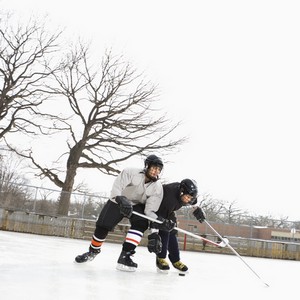 Exercising InjuryNerve “pinch”/compression
Exercising InjuryNerve “pinch”/compressionOften pain referring down the leg is blamed on a “pinched nerve” or “sciatica”. Nerves can be “pinched” in the back from a disc injury, with osteoarthritis, degenerative changes or from an injury.
- Typical nerve pain is severe and sharp/stabbing
- An cause numbness, total loss of feeling or weaknesses
- True nerve compression is not very common. More often pain referral stems from muscle, joint and disc problems – even if the nerve is not being directly affected
Often pain is blamed on osteoarthritis. Degenerative damage like osteoarthritis can trigger pain episodes, but that pain often persists for other reasons. The goal of treatment is to identify the underlying factors for the reoccuring pain, and to bring those issues under control with a combination of treatment, home exercises and ergonomic changes.
While it is not possible to undo the arthritic changes, treatment can often restore normal function and reduce pain.
 Pregnancy Back PainTreatment
Pregnancy Back PainTreatmentTreatment must always start with an appropriate diagnosis.
Treatments should focus on the underlying cause of the pain - both the tissue causing the pain as well as the factors triggering the problem. A combination of treatments, such as, massage, soft tissue treatments (Graston), manipulation/mobilization and/or home stretching exercises can be effective ways to reduce the tissue irritation.
We identify aggravating factors and help you manage any issues through a program of self-care and prevention.
For a clinical assessment of your lower back pain, the triggers and best treatment options, please contact Bedford Chiropractic for an appointment.

